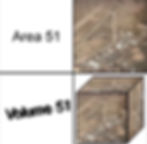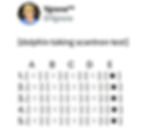Digital SAT - Math Module Skills & Strategies
- LearnCurious
- Mar 12, 2024
- 4 min read
Wondering how to get a good score (or improve your scores) on the new digital SAT math modules?
Use your resources
On the digital SAT, there are several tools (new and old) available to help students maximize their time and stay organized:
Reference Formulas The image below is the reference formula information that will be available to students for each math module question:

Desmos Graphing Calculator This is often the most useful and impactful tool available on both math modules of the digital SAT. On previous paper-based SATs, there was a 'no calculator' math section, designed to test students' abilities to solve questions by hand. THIS HAS DISAPPEARED and has been replaced with math modules that often require strategic calculator use in order to finish the questions in the allotted time.

strikethrough tool - for eliminating answers
annotator tool - for highlighting important bits
'mark for review' tool - to note questions to come back to later if time allows
countdown clock - to keep track of how much time has passed and how much is left
Know what's coming
Math content on the digital SAT covers...
Algebra
Problem Solving & Data Analysis (PSDA)
Geometry & Trigonometry
Advanced Skills
Here's a more specific breakdown of what these vague topics actually test:
ALGEBRA
linear equations, inequalities, & functions
systems of linear equations, inequalities, & functions

PROBLEM SOLVING AND DATA ANALYSIS
graph interpretation
bar / line / scatterplot / box-and-whisker plot / histograms
rates, ratios, & proportions
speed/density
unit conversion
fraction operations
linear rate functions
central tendency / evaluating statistical claims
mean / median / mode / range / standard deviation
distribution diagram interpretation and vocabulary
making data inferences and interpreting margin of error
percentages
probability & relative frequency
interpreting frequency tables & two-way tables

GEOMETRY / TRIGONOMETRY
triangles
perimeter / area
similarity & congruence
SOHCAHTOA right triangle trigonometry rules and relationships
special right triangles
inscribed shapes
Pythagorean Theorum
geo/trig skills continued...
angles
parallel / perpendicular lines / transversals
vertical / complementary / supplementary angle rules
quadrilaterals
squares / rectangles / rhombi / parallelograms / trapezoids
perimeter / area
circles
radius / diameter / area / circumference
arc length & sector area proportion calculations
converting between radians and degrees
circle graph / equation interpretation
completing the square
unit circle

geo/trig skills continued...
volume & surface area
cubes / rectangular prisms / cylinders

ADVANCED SKILLS
quadrilaterals
factoring / FOILing
solving quadratic equations and functions
evaluating number of quadratic solutions from given equation(s)
word problems with constants
vertex form / finding the vertex of a parabola

advanced skills continued...
higher-degree polynomials
combining like terms and isolating variables
radical, rational, and negative exponent rules
factoring and interpreting non-linear function diagrams
word problems with constants

advanced skills continued...
systems of linear and quadratic equations & inequalities
evaluating radicals, roots, and absolute values
equation translations
arithmetic / geometric sequences
Use test-taking strategies
PROCESS OF ELIMINATION
When in doubt on a question, using process of elimination is a great way to increase your chances of getting the question correct.

TIME MANAGEMENT
While the digital SAT is considerably shorter than its paper-based predecessor, this also means that time management is an even bigger component of getting a high score.
Using Desmos, particularly on the higher-level math module, is KEY to managing time effectively and getting through all of the questions in the time allotted. It is a fantastic use of study time to practice using Desmos to interpret given equations, visualize graphs, and answer difficult math questions.
Even if you're familiar with how to solve difficult math questions by hand, this is no longer what the test is designed to assess. It is now a question of how well students are able to use the given resources in the allotted time. So, if it's going to be even a little bit faster to solve a question using Desmos, use it!
GUESSING
There is no guessing penalty on the digital SAT, so it pays to guess on any questions students may be unsure about or run out of time for in any of the digital SAT's modules; this is true for both multiple choice and fill-in-the-blank questions in the math modules.
If there is a group of questions left to guess on, it's better to choose one letter and stick with it (instead of randomly choosing different letters for each of the questions). Statistically, it's more likely to get more 'free' points by sticking with one letter -- even if the questions needing guesses are spaced out throughout the section!
Note: it's a myth that "C" is the most commonly-occurring answer choice. It's just as likely for A, B, or D to be correct for multiple choice questions on any given test or module. So, whichever letter is your favorite (A, B, C, or D), pick that one and stick with it!

ANXIETY MANAGEMENT
If you or someone you know experiences test anxiety or math anxiety, this post can help!
Digital SAT Math Module Strategy Summary
In order to do well on the math modules of the digital SAT, it's important to use the resources provided in the test application, know (and practice!) the concepts and skills that are most likely to appear on the test, and use test-taking strategies to maximize time and energy.

TL;DR
If you skimmed this for the memes, keep this last one in mind as a takeaway:

Want help with learning and practicing math?
You may also be interested in...

About LearnCurious:
LearnCurious is dedicated to helping students improve their scores on college admissions tests like the digital SAT and ACT exams. Our goal is to provide high-quality practice questions written according to the latest formatting guidelines available.
All content presented by LearnCurious is thoroughly researched and tested by test prep experts and experienced tutors to ensure that it provides the most effective preparation possible to students studying for their college entrance exams.
We also offer private K-12 school subject & test prep tutoring as well as an annual writing scholarship! For more information, please visit www.learncurious.com.
Note: SAT® is a trademark registered and/or owned by the College Board, which is not affiliated with or involved in the production or endorsement of this post.

